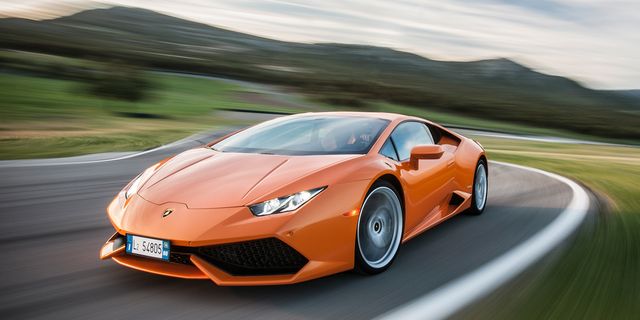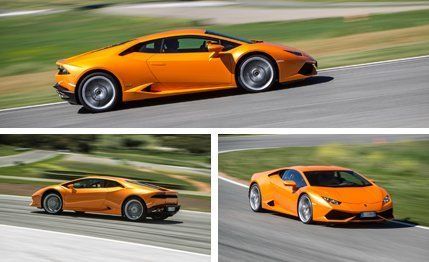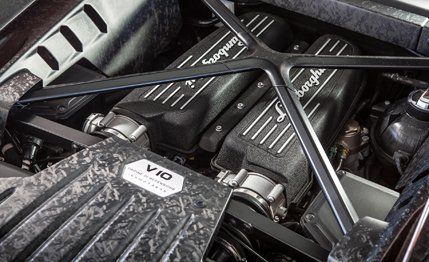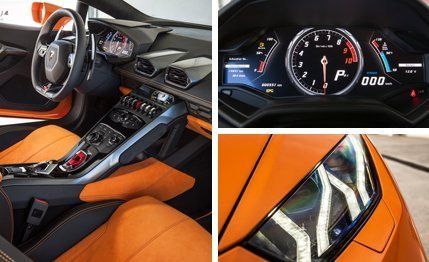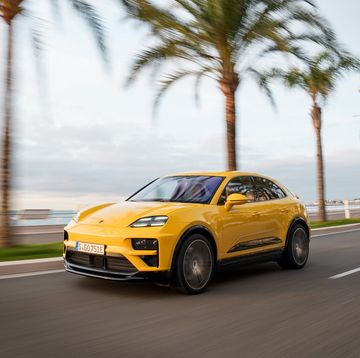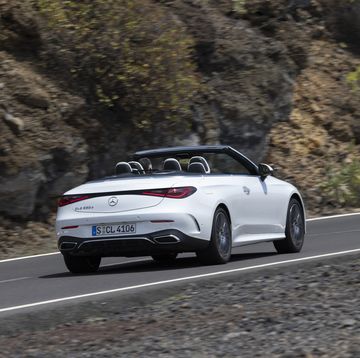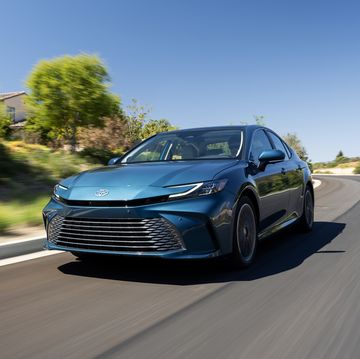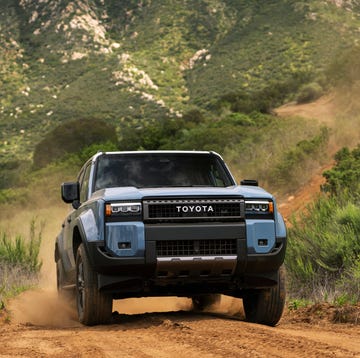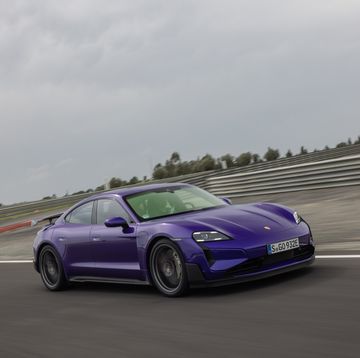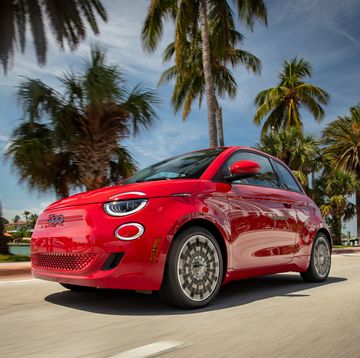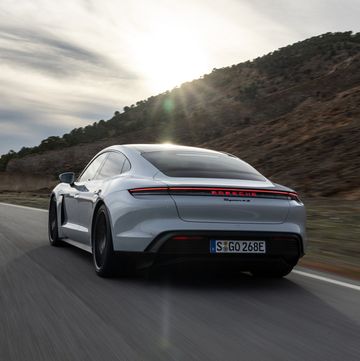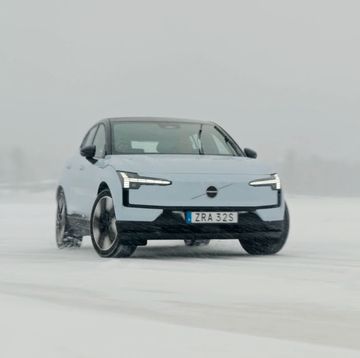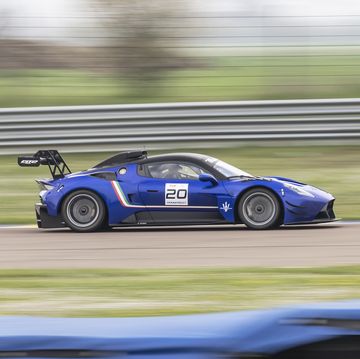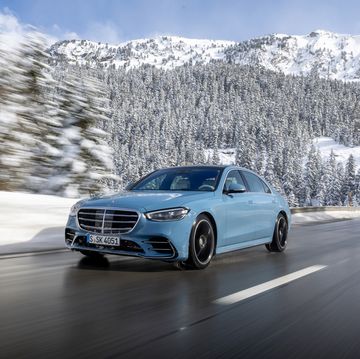You expect a lot of things to happen when you drive a Lamborghini Huracán. It’s a supercar, after all, capable of 202 mph and running from zero to 60 mph in an estimated 2.9 seconds. It starts at more than $240,000 and is powered by a 602-hp, 5.2-liter V-10. You expect intimidation and excitement. What you don’t expect is that this car is woefully ineffective at killing bugs. Well, it’ll kill them on the front bumper, but the windshield is so steeply raked that bugs miss the front glass entirely; it was free of viscera even after several hours of high-speed driving.
The Huracán is an entirely new Lamborghini. But it is still very much a Lamborghini, which means it looks like a shark made out of polygons. The edges and points aren’t as sharp as those of this car’s big brother, the Aventador, so the latest Lambo appears understated. Of course, this is a relative comparison—the Elephant Man’s sister probably got less attention when the two went out to dinner.
The Huracán’s skin and underlying structure are mostly aluminum. Architecturally, the big leap forward is the use of carbon fiber in the rear bulkhead, center tunnel, and portions of the B-pillars. The composite accounts for a 10-percent weight reduction and is part of a 50-percent increase in rigidity compared with its predecessor, the Gallardo. The carbon-fiber pieces are glued, baked, and riveted into the aluminum structure. Like the Gallardo, the Huracán’s core is assembled in Neckarsulm, Germany. Bodies arrive at the Lamborghini factory fully painted and ready for final assembly.
In fact, a lot of the new Lamborghini Huracán doesn’t come from Italy. Audi owns and manages the supercar concern, and, as a result, the brand isn’t the lira-hemorrhaging Italian space program that once launched cars like the Countach and the Jalpa into the outer atmosphere. Those cars were better at thrusting Lamborghini into receivership than reliably taking owners anywhere. The Germans are in charge now, and they have standards.
Another part of the Huracán that arrives in Italy ready to go is the 5.2-liter V-10 engine. Built in Gyo˝r, Hungary, the Huracán’s engine makes 50 more horsepower than the Gallardo LP560-4’s, or 52 more than the version in the current Audi R8 V-10 Plus. A new dual-fuel-injection system and revised intake deserve most of the credit for the extra power. According to Lamborghini, the direct- and port-fuel-injection systems work to cut emissions, add power, and improve fuel economy. No EPA figures are available yet, but 15 city/21 highway mpg figures are a good guess.
Unfortunately, there’s no manual option with which to lash the V-10. Too few Gallardos were sold with three pedals, so now the Huracán comes exclusively with a seven-speed dual-clutch automatic. Paddle shifters allow the driver to select gears, or, if left in automatic mode, the transmission will try its best to keep you in the correct gear without sucking down too much fuel.
When it’s turning at its 8500-rpm redline, the V-10 sounds like Pavarotti gargling premium. But we wish it were exclusive to the Huracán and not shared with the R8. There’s something annoying about sharing; even kindergartners get that. Lamborghinis deserve their own crazy engines—the Aventador’s 8500-rpm V-12 is a part of Lamborghini history and is exclusive to the car. Sharing a V-10 with an Audi erodes the Huracán’s exotic pretense, though it likely enables lower costs and greater reliability.
The Huracán’s interior, though, is the perfect mix of the exotic and the practical. Inspired by the ’67 Lambo Marzal, a hexagon-themed concept car, the cockpit has a retro flavor. Hex-shaped vents sit atop the flat dash and match the six-sided instrument cluster, which houses a 12.3-inch TFT screen that can be configured to show a tachometer, speedometer, audio, phone, and navigation maps and directions.
Specifications
Tony Quiroga is a 20-year-veteran Car and Driver editor, writer, and car reviewer and the 19th editor-in-chief for the magazine since its founding in 1955. He has subscribed to Car and Driver since age six. "Growing up, I read every issue of Car and Driver cover to cover, sometimes three or more times. It's the place I wanted to work since I could read," Quiroga says. He moved from Automobile Magazine to an associate editor position at Car and Driver in 2004. Over the years, he has held nearly every editorial position in print and digital, edited several special issues, and also helped produce C/D's early YouTube efforts. He is also the longest-tenured test driver for Lightning Lap, having lapped Virginia International Raceway's Grand Course more than 2000 times over 12 years.
